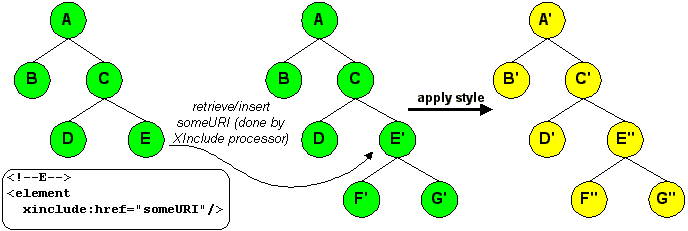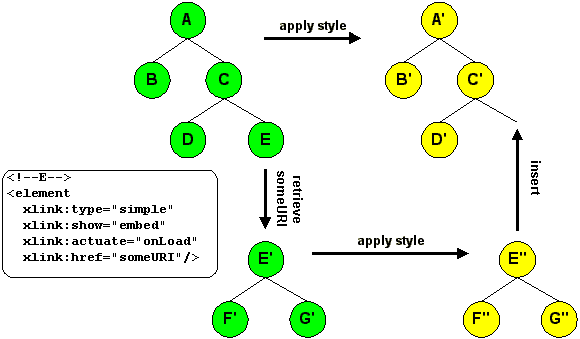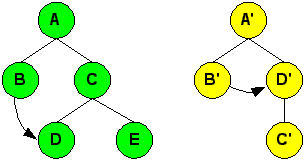After much consideration, we arrived at the conceptual model which
follows. This model exposes a significant issue in the interaction between
the current technologies for linking and styling: [XPointer]
can address documents at the character level whereas
[XSLT] can only address documents at the text-node level.
We show that by selecting specific defaults within the model, we
can provide expected functionality with current technology. As the
technology of linking and styling matures, we'll be able to exploit
more of the model with standard technologies. (Implementations will
be able to exploit the entire model immediately by employing extensions
to standard functionality.)
4.1 A Conceptual Model for Styling Link Traversal
From a styling perspective, link traversal requires the styling
application to retrieve the document which contains the ending
resource, style it, and present it. In addition, the ending resource
may get special treatment. It might, for example, be shown in reverse
video
or the document view might be adjusted so that the ending resource
appears at the top of the viewing context.
Displaying the styled result is a complex problem because links are
between source documents, not between their styled results.
Consider, for example, an XLink cross-reference:
See <xref xlink:type="simple" xlink:href="#ch5">Chapter 5</xref> |
This link expresses a relationship between the text "Chapter 5" and
the element with an ID of "ch5" elsewhere in the document. It provides
no specific information about the formatted result that might be
presented to the reader. Online, this might become a hypertext link to
some other location whereas in print it might be rendered simply as a
page number in parenthesis (or not at all).
The arbitrary nature of styling transformations can make this
problem even more complex, as when the target in the source document
is rendered in multiple locations in the presented result
(See 5 Discontiguous Resources).
We may also want to consider how much of the document that contains
the ending resource we wish to display. HTML browsers traditionally
retrieve the entire resource and display it, moving the viewing
context to the point where the ending resource occurs. In the case of
XML documents, we may wish to have more control. We add one additional
generalization to the conceptual model for this purpose.
Rather than presenting the entire resource, we might want to
display a subresource within the document that is
different from the subresource that is the ending resource of
the link. For example, to style a link to a figure within a book, we
might want to display the whole chapter that contains the figure:
<doc id='process'>
<chap>...</chap>
<chap>...</chap>
<chap id='present'>
<p>...</p>
<figure id='target'>
...
</figure>
<p>...</p>
<p>...</p>
</chap>
<chap>...</chap>
</doc> |
In other words, we might wish to style a link by processing a whole
document (in order to get chapter numbering correct, for
example), present the third chapter in the user agent, and highlight
the figure.
We describe this in terms of three distinct contexts, each identified
by a URI reference (probably including an [XPointer]
fragment identifier in most cases):
[Definition: The
Processing Context of a link traversal is the resource (or
portion of a resource) that is available to the style engine.]
Informally, this is the tree that is available to the styling
application. Usually this is the whole document.
[Definition: The
Presentation Context of a link traversal is the resource (or
portion of a resource) that is effectively the source resource to be
styled.]
In other words, the results of styling the [Presentation Context] is
the content that is presented in the user agent. Often this is the whole
document.
[Definition: The
Target of a link traversal is the ending resource of the link.
]
These components, plus the stylesheet to be used,
are present in the Infoset contributions
described in 2.1.1 XLink Infoset Contributions. However, the current XLink
specification does not provide standard ways to provide all of these
components. Rather than request possibly contentious additions to XLink
at this late date, we recommend using default values for several
components.
For embedded resources, we recommend that the default processing
and presentation contexts be the same as the target (see 6.2 Ranges that are Presentation Context). For resources displayed with "new" or
"replace" semantics, we recommend that the default processing and
presentation contexts be the whole document that contains the ending
resource.
In any case, the application
has considerable freedom in selecting the appropriate stylesheet. In some
applications it may make sense to use the same stylesheet as the source
document (particularly, perhaps, in the "embed" case); in others it may
make sense to use the XML Stylesheet PI ([XML Stylesheet PI])
from the target document or some other application-specific selection.
Application-specific behavior can be modeled with extension metadata
in the XLink linking elements. If useful subsets of this behavior become
common, a future version of XLink may promote them to standard elements.
4.1.1 Special Considerations for Embedded Resources
The model articulated here is the most consistent and
rational model that we could imagine. It does not,
however, produce exactly the results that might be expected in all
cases. In particular, embedding resources requires special
consideration. (Embedding resources identified by XPointer ranges
is even worse; see 6.2 Ranges that are Presentation Context.)
Consider the following documents, doc1.xml:
<doc>
<?xml-stylesheet href="style1.xsl" type="text/xsl"?>
<list>
<item>x xxxx</item>
<item>xxx xx xxxx</item>
<embed xlink:type="simple"
xlink:show="embed" xlink:actuate="onLoad"
xlink:href="doc2.xml#xpointer(//list[1]/item[2])"/>
<item>xxxxx</item>
</list>
</doc> |
and doc2.xml:
<doc>
<?xml-stylesheet href="style2.xsl" type="text/xsl"?>
<list>
<item>y yyyy</item>
<item>yyy yy yyy</item>
<item>yyyy</item>
</list>
</doc>
|
Suppose that style1.xsl styles lists with Arabic
numerals and style2.xsl styles them with Roman numerals
(and no other significant transformations are performed). What will
the results be?
If the embedded fragment is processed with style1.xsl,
the result will be something like this:
1. x xxxx
2. xxx xx xxxx
2. yyy yy yyy
4. xxxxx |
(In fact, it is even possible that the last item will be numbered "3"
if the stylesheet is only counting <item>s, but that
can be avoided in the stylesheet.)
If the embedded fragment is processed with style2.xsl,
the result will be something like this:
1. x xxxx
2. xxx xx xxxx
ii. yyy yy yyy
4. xxxxx |
In neither case will the result that the author probably had in mind
(namely 1, 2, 3, 4) be the result.
In fact, the desired result can be achieved, but only by constructing
the source document in an appropriate way:
<doc>
<?xml-stylesheet href="style1.xsl" type="text/xsl"?>
<list>
<item>x xxxx</item>
<item>xxx xx xxxx</item>
<item><embed xlink:type="simple"
xlink:show="embed" xlink:actuate="onLoad"
xlink:href="doc2.xml#xpointer(//list[1]/item[2]/node())"/>
</item>
<item>xxxxx</item>
</list>
</doc> |
By selecting only the content of the target list item, we allow the
stylesheet for the source document to number all of the items in a logical
way.
This is hardly the best possible situation, but no superior alternative
seems evident.
Since both of these documents seem to use the same tag set,
it may have been closer to the author's original intention to style a
document that contained a merged source document (as
might be achieved with [XInclude])
rather than merging the
styled results
(as is achieved with [XLink]).
See 4.1.3 XInclude vs. XLink Embedding.
4.1.2 Result Tree Numbering
To compound the situation further, the two most popular
presentation formats for XML documents, HTML and XSL Formatting
Objects, perform numbering in completely different ways.
In the HTML, list item numbering is actually done by the formatter,
whereas it is done by the transformation that produces FOs in
XSL. This means that the first example described above will
actually work for HTML but not for XSL FOs.
Conversely, if the desired result was a mixture of numbering systems
(as might be the case in a legal document, perhaps), the former result
could not be achieved in HTML without considerable effort.
Consider how the stylesheets would likely produce formatting objects
for the doc1.xml:
<list-block>
<list-item>
<list-item-label><block>1.</block></list-item-label>
<list-item-body><block>x xxxx</block></list-item-body>
</list-item>
<list-item>
<list-item-label><block>2.</block></list-item-label>
<list-item-body><block>xxx xx xxxx</block></list-item-body>
</list-item>
<list-item>
<list-item-label><block>2.</block></list-item-label>
<list-item-body><block>yyy yy yyy</block></list-item-body>
</list-item>
<list-item>
<list-item-label><block>4.</block></list-item-label>
<list-item-body><block>xxxxx</block></list-item-body>
</list-item>
</list-block> |
As you can see, the list item numbers are textually part of the
result tree. This is not so in the HTML case:
<ol>
<li>x xxxx</li>
<li>xxx xx xxxx</li>
<li>yyy yy yyy</li>
<li>xxxxx</li>
</ol> |
The list items are enumerated by the browser in the HTML case,
so the numbering will be sequential.
4.1.3 XInclude vs. XLink Embedding
The distinction between [XInclude] and
[XLink] deserves special consideration.
At a high level, [XInclude] is similar to
external entity references in [XML]. That is,
the inclusion is done at or shortly after parsing, before style
is applied. As you can see in the following figure, the element
"E" is identified as an XInclude element and the content
of the source tree is modified prior
to styling:

Embedded XLinks, as we've described them, are handled during the
styling process. When an embedded XLink is processed, the
result of styling the ending resource
of the link is merged into the
result of styling the document into which it is embedded.

The decision about whether to use an [XInclude] or
an embedded [XLink] is very dependent on the
application. As a general rule, if the resource being embedded is
from the same schema as the embedding document, and it will be styled
with the same stylesheet, [XInclude] is probably a
good choice. If the embedded document is from a different schema, or
requires a different stylesheet, [XLink] is probably
the right choice.


